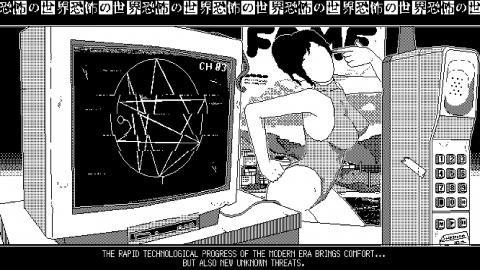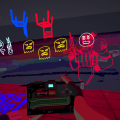- WORLD OF HORROR (2017 Early Build)
- WORLD OF HORROR
It’s been six years since WORLD OF HORROR first showed up on itchio. It eventually got picked up by a publisher and entered early access in 2020, where it was worked on here and there by developer panstasz while he was doing IRL dentist work, well off the original planned schedule. The wait was well worth it, though, as the complete 1.0 version is now done and the game has left Early Access, showing a ton of polish compared to the 2020 version, and is almost unrecognizable to the 2017 early build from way back when.
For those new, WORLD OF HORROR is a roguelike RPG done in the style of the works of horror manga icon Junji Ito, with a dash of H.P. Lovecraft eldritch horror. The idea is that it is the year 198X, and an eldritch god is being drawn into the world, which will mean the end of all things if it happens. You have to go through a handful of cases to figure out connections, gain keys to a lighthouse at each case’s end, and get to the top to banish the god and save the world. Easier said than done.
The game’s big draw is the 1-bit graphical illustrations literally made in MSPaint, filled with an incredible amount of detail in every aspect to make an early Mac style interface via 80s Japanese PC game menu design. The 2017 early build was already striking at the time, but looking at what we have as of this finished release is like night and day. You can spot a few similarities, but there’s been a lot of effort in making character sprites and hub design more detailed and polished.
This has erased the early charming but crude attempts at mimicry of Junji Ito’s style with a more fleshed out version of that art style. A lot of attention was paid to expressions, in particular, to really sell the character’s described personality and skill set. For example, making the idol character have a permanent tooth filled smile really sells her charisma. Monsters also look far more grotesque than ever, even occasionally using unique effects like glitch animations.
The HUD is also pretty clean and easy to use, despite how it may scare some used to more minimalist menus today. There are detailed pop ups that explain what each button does, so understanding what they do from just a glance becomes almost second hand fairly quickly. It’s a have cake and eat it too situation, where the game is able to emulate the looks of old Japanese computer games without the difficulties of understanding the huds. There is indeed a touch of modern design principles here, and it makes the overall experience easier to handle then you would expect.
The general structure is that a run will take around an hour. You can pick your character, the god you’ll be dealing with and the unique debuff it puts on the whole run, and can customize the run in a variety of ways. The general flow for cases is having you move from place to place with a menu and investigating circled areas to advance the case. This leads to random events that can have good and bad outcomes with skill checks mixed in, or a possible random battle with one of the evils haunting the city. The end of the case can have a wide variety of outcomes, and sometimes give you something that can affect another case, but it often depends on if you finished a side objective or various other variables.
Along with your various stats that you can increase on level ups, you have stamina and reason, acting as your physical and mental health pools, often lowering with events that test you in those areas. If one of those goes out, it’s game over, time to start another run. On top of that, there’s a doom meter slowly increasing with your actions being counted on the top of the screen via a bar that shows a void overtaking the lighthouse. If that hits 100%, the god you’re trying to stop arrives and destroys the world. Actions like looking for followers at the school yard or visiting the shiba-inu run shop can also increase the doom meter, so it’s rare you’re safe from that growing doom.
The battle system is also surprisingly fun and fleshed out now. You have a much wider selection of options including trying to exorcise ghost enemies, and a lot of extra info is obfuscated so you can focus on the most important information. The bosses at the end of many cases also have completely unique mechanics and actions tied to them, like an extremely strong eldrich monster’s weakpoint being its connection with this realm via a cult leader trying to summon it that needs to be attacked instead. There are way more examples but it’s much more rewarding to find them yourself.
There are a shocking number of variables in how cases can go, so no one run ever feels the same as the last. On top of that, there is an in-game achievement system you can check out in the extras menu. As you gain these achievements, more content in the game will unlock, including new characters, events, backstories, outfits, and much more. This gives more reason to keep coming back, to see what else you can uncover and see you hadn’t before. This also extends to case endings, the game informing you how many a case has before you pick it and also showing which endings you’ve previously seen.
To give you an idea how varied things can be, the ending of a case revolving around a mansion’s hidden cavern can be decided on if you brought a flashlight and equipped it or not, among other things. This also includes the various random events, where you gain new options if you have certain items, skills from level ups, followers, and more. Even fights are affected, like having a good weapon being key to being able to damage ghost enemies via severing their ties to the mortal plain. Otherwise, physical attacks do nothing.
There’s not really a weak element to WORLD OF HORROR to be found. Even the music stands out with its simple beeps and boops creating some strong horror tinged tracks, even mixed in clever ways alongside some animated effects. It’s simply great stuff, one of the strongest roguelikes you can hope to find on the market by a large margin. The art, the writing, the RPG systems driving it all, and everything else mix almost perfectly to create an addictive game with a fresh style, even six years since it first popped up. With even difficulty customization to make runs more manageable, there’s no excuse not to try it out.


